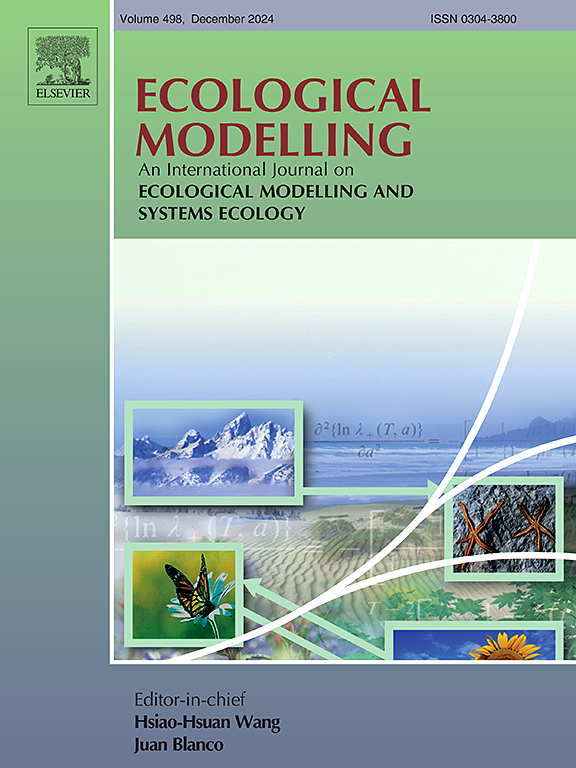Monitoring with multiple goals: Bayesian methods for changing objectives
IF 3.2
3区 环境科学与生态学
Q2 ECOLOGY
引用次数: 0
Abstract
Long-term monitoring is essential for wildlife conservation. Most wildlife population attributes require long-term monitoring to evaluate. Over the time for attributes to resolve through monitoring, however, information needs change. Existing frameworks to accommodate information need changes, such as adaptive monitoring and management, are built for large-scale, programmatic changes. Often, smaller, rapid changes are necessary. Fortunately, information needs can change predictably in wildlife monitoring, even when little is known about populations. Predictable changes include the desire to answer: 1) is the species present?; 2) are multiple individuals present?; 3) is breeding occurring?. We suggest long-term monitoring can accommodate these changes. We propose Goal Efficient Monitoring (GEM), an approach that uses a Bayesian integrated population model (BIPM) to accommodate changing information needs through: a BIPM that links population state changes (e.g., present, multiple individuals present) to population dynamics (e.g., abundance, demographic rates); and sampling rules to allocate effort observation effort based on current knowledge. To test the efficacy of a GEM approach, we ask two research questions: 1) can implementing a GEM approach provide robust population estimates?; and 2) do GEM sampling rules in multiple long-term monitoring settings (i.e., population sizes) accommodate changing questions while providing continual, reliable population inference? To answer these questions, we built a BIPM and conducted a simulation study for a rare species in the US, Canada lynx (Lynx canadensis). We simulated lynx populations under five different starting conditions and simulated a GEM approach (10 years of simulated observations with GEM sampling rules), then used our BIPM model to produce estimates and predictions. In 93 % of simulations, 95 % credible intervals for BIMP estimates contained the true value for all biological (abundance of all sexes and age classes, birth events, survival, state transition probabilities) and observation variables (detection probabilities). We demonstrate how a GEM approach can provide reliable long-term inference while being responsive to shifting information needs.
多目标监控:改变目标的贝叶斯方法
长期监测对野生动物保护至关重要。大多数野生动物种群属性需要长期监测来评估。但是,在通过监视解决属性的过程中,信息需要发生变化。用于适应信息需求变化(如自适应监视和管理)的现有框架是为大规模的程序化变化而构建的。通常,较小的、快速的变化是必要的。幸运的是,在野生动物监测中,即使对种群知之甚少,信息需求也会发生可预测的变化。可预测的变化包括想要回答:1)物种是否存在?2)是否有多人在场?3)是否有繁殖发生?我们建议长期监测可以适应这些变化。我们提出目标有效监测(GEM),这是一种使用贝叶斯综合人口模型(BIPM)来适应不断变化的信息需求的方法:将人口状态变化(例如,当前,多个个体存在)与人口动态(例如,丰度,人口比率)联系起来的BIPM;并根据现有的知识进行抽样规则分配。为了检验GEM方法的有效性,我们提出了两个研究问题:1)实施GEM方法能否提供可靠的人口估计?2)在多个长期监测设置(即人口规模)中,GEM抽样规则是否能够适应不断变化的问题,同时提供持续可靠的人口推断?为了回答这些问题,我们建立了一个BIPM,并对美国稀有物种加拿大猞猁(lynx canadensis)进行了模拟研究。我们模拟了五种不同初始条件下的猞猁种群,并模拟了GEM方法(基于GEM抽样规则的10年模拟观测),然后使用我们的BIPM模型进行估计和预测。在93%的模拟中,BIMP估计的95%可信区间包含所有生物(所有性别和年龄类别的丰度,出生事件,生存,状态转移概率)和观察变量(检测概率)的真实值。我们将演示GEM方法如何在响应不断变化的信息需求的同时提供可靠的长期推断。
本文章由计算机程序翻译,如有差异,请以英文原文为准。
求助全文
约1分钟内获得全文
求助全文
来源期刊

Ecological Modelling
环境科学-生态学
CiteScore
5.60
自引率
6.50%
发文量
259
审稿时长
69 days
期刊介绍:
The journal is concerned with the use of mathematical models and systems analysis for the description of ecological processes and for the sustainable management of resources. Human activity and well-being are dependent on and integrated with the functioning of ecosystems and the services they provide. We aim to understand these basic ecosystem functions using mathematical and conceptual modelling, systems analysis, thermodynamics, computer simulations, and ecological theory. This leads to a preference for process-based models embedded in theory with explicit causative agents as opposed to strictly statistical or correlative descriptions. These modelling methods can be applied to a wide spectrum of issues ranging from basic ecology to human ecology to socio-ecological systems. The journal welcomes research articles, short communications, review articles, letters to the editor, book reviews, and other communications. The journal also supports the activities of the [International Society of Ecological Modelling (ISEM)](http://www.isemna.org/).
 求助内容:
求助内容: 应助结果提醒方式:
应助结果提醒方式:


